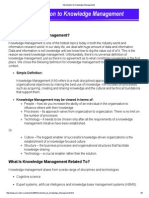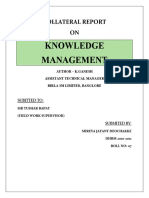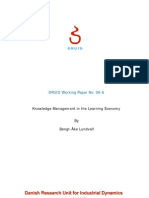The Relation Between KM and ICT
The Relation Between KM and ICT
Uploaded by
Abhiram KarthaCopyright:
Available Formats
The Relation Between KM and ICT
The Relation Between KM and ICT
Uploaded by
Abhiram KarthaOriginal Description:
Original Title
Copyright
Available Formats
Share this document
Did you find this document useful?
Is this content inappropriate?
Copyright:
Available Formats
The Relation Between KM and ICT
The Relation Between KM and ICT
Uploaded by
Abhiram KarthaCopyright:
Available Formats
The term Knowledge management is used to refer to a broad collection of organizational practices and approaches related to generating, capturing,
disseminating know-how and other content relevant to the organizations business. Some would argue that knowledge management is a contradiction in terms, being a hangover from an industrial era when control modes of thinking were dominant. Thus knowledge is not just an explicit tangible thing, like information, but information combined with experience, context, interpretation and reflection. Knowledge involves the full person, integrating the elements of both thinking and feeling. Hence some object to the use of the term knowledge management as revealing a fundamental misunderstanding of the nature of knowledge. Many organizations see knowledge sharing as a better description of what they are about than knowledge management. Advantages of knowledge sharing include its commonsense comprehensibility, along with a certain degree of interactivity implicit in any sharing. Overall, whatever the term employed to describe it, knowledge management is increasingly seen, not merely as the latest management fashion, but as signaling the development of a more organic and holistic way of understanding and exploiting the role of knowledge in the processes of managing and doing work, and an authentic guide for individuals and organizations in coping with the increasingly complex and shifting environment of the modern economy. The relation between KM and ICT The reach of know-how and experience possessed by individuals can be greatly extended once it is captured and explicated so that others can easily find it, understand and use it. The invention of writing and then the printing press were obviously critical steps. In modern times, reports of activities, minutes of meetings, memoranda, proceedings of conferences, and document filing systems maintained by organizations are traditional commonly used devices for recording content in paper format so that it can be transferred to others. More recently, electronic databases, audio and video recordings, interactive tools and multimedia presentations have become available to extend the techniques for capturing and disseminating content. Although these tools are not yet available everywhere in the developing world, they are spreading rapidly and present a unique opportunity for developing countries to benefit most from the technological revolution now unfolding: low-cost telecommunications systems can help countries to leapfrog ahead through distance education, distance health services, and much better access to markets and private sector partners abroad. Nevertheless, even with modern tools, the process of knowledge transfer is inherently difficult, since those who have knowledge may not be conscious
of what they know or how significant it is, or be able or willing to share it with others. Even when they are so willing, the readiness to accept the wisdom of others is often not obvious. Thus know-how is sticky and tends to stay in peoples heads. The availability of new information and communications technology (ICT), particularly the World Wide Web, has been instrumental in catalyzing the knowledge management movement. ICT may, if well resourced and implemented, provide a comprehensive knowledge base that is speedily accessed, interactive, and of immediate value to the user. However there are also many examples of systems that are neither quick, easy-to-use, problem free in operation, or easy to maintain. The Web, for example, frequently creates information overload. The development of tools that support knowledge sharing in an appropriate and user-friendly way, particularly in organization wide knowledge sharing programs, is not a trivial task. Most of the technological tools now available tend to help dissemination of know-how, but offer less assistance for knowledge use. Tools that assist in knowledge creation are even less well developed, although collaborative workspaces offer promising opportunities, by enabling participation, across time and distance, in project design or knowledge-based development, so that those most knowledgeable about development problems the people living them on a day-to-day basis can actively contribute to their solution. Some of the more user-friendly technologies are the traditional ones face-to-face discussions, the telephone, electronic mail, and paper-based tools such as flip charts. There is now an increasing awareness that the much heralded paperless office is unlikely to occur any time soon. High-tech has tended to enhance the need for paper, not eliminate it. Criteria for the use of ICT in KM Among the issues that need to be considered in providing information technology for knowledge sharing programs are: responsiveness to user needs: continuous efforts must be made to ensure that the information technology in use meets the varied and changing needs of users. content structure: in large systems, classification and cataloguing become important so that items can be easily found and quickly retrieved. content quality requirements: standards for admitting new content into the system need to be established and met to ensure operational relevance and high value. capacity to handle narrative: much knowledge is embedded in narratives, and unless the technology is adapted to narrative, it will be less than useful in knowledge transfer. integration with existing systems: since most knowledge sharing programs aim at
embedding knowledge sharing in the work of staff as seamlessly as possible, it is key to integrate knowledge-related technology with pre-existing technology choices. scalability: solutions that seem to work well in small groups (e.g. HTML web sites) may not be appropriate for extrapolation organization wide or on a global basis. hardware-software compatibility is important to ensure that choices are made that are compatible with the bandwidth and computing capacity available to users. synchronization of technology with the capabilities of users is important so as to take full advantage of the potential of the tools, particularly where the technology skills of users differ widely. Knowledge sharing programs that focus on the simultaneous improvement of the whole system, both technology tools and human practices, are likely to be more successful than programs that focus on one or the other. The equation of KM and ICT One of the major problems in knowledge management programs has been the tendency for organizations to confuse knowledge management with some form of ICT, whether it be Lotus Notes, the World Wide Web, or one of the off-the-shelf technology tools that are now proliferating. In the process, the essentially ecological concept of knowledge sharing becomes degraded into a simple information system that can be engineered without affecting the way the work is done. It is not that information systems are bad. Rather, it is important to recognize that knowledge management is a different and more efficient way of working that affects people, and requires social arrangements like communities to enable it to happen on any consistent and sustained basis. The confusion of ICT and KM was evident in some of the pronouncements emanating from the ECOSOC resolutions of July 2000, where the promotion of ICTs and knowledge was seen a key for the whole process of development. This also reflected developments in the private sector, particularly in the United States; large scale investments in ICT have been made in the name of knowledge management. Thousands of millions of dollars have been spent in order to do KM. In The Wealth of Knowledge , Tom Stewart writes that in the spring of 2000, three out of four senior executives believed the internet would completely transform every aspect of business; more than half said the change would put away the old rules about how companies should operate. This was a highwater- mark of sorts, in that it was a time of considerable irrational exuberance, to use the words of Alan Greenspan, the chairman of the US Federal Reserve Board. Many of the promoters of high tech were wearing clothes borrowed from knowledge management. In effect, analysts and stock-hypers, eager to push valuations to new highs, used some new-economy realities (for example, the fact that a lot of highvalue assets arent shown in the formal accounts of an organization) to lend
credence to the bubble. One of the underlying problems in many KM programs was that there was a lack of an explicit connection between the idea of sharing knowledge and the objectives of the organization in which knowledge was being shared. In the modern economy, there is the generally accepted insight that it is the thinking knowledge, intellectual capital, understanding that often tips the balance between success and failure. But what was less widely understood was the link between this insight and the way of turning it into action, and becoming an agenda for improved organizational performance. In effect, the talk often failed to translate strategic insight into organizational value.
The equation of the New Economy and the dot-com bubble
When there is irrational exuberance, there is inevitably a backlash. With the bursting of the Nasdaq bubble, it is often said that the New Economy was just about the internet and reflected merely a lot of hype to drive Nasdeq stock prices to the giddy, effervescent, irrational heights they attained in 2001. The New Economy of knowledge was however not about the dot-com bubble, nor was it principally about the Web and even high-tech, even though the dot.com bubble clothed itself in New Economy rhetoric. It was, and still is, about growth in productivity. A jump basically a doubling in the underlying productivity growth of the US economy; and surprisingly this growth continued even during the recession, an unprecedented phenomenon in a US recession. The productivity growth was built by the convergence of telecommunications and computing. It was created by the managing of information with the kind of efficiency and agility with which organizations long ago learned to manage materials. Productivity growth was ultimately built on developing, deploying, and investing in knowledge assets. With the rapidly changing business world, companies are facing a host of questions in a turbulent business world: How to encourage more dialogue among employees? How to encourage better interaction between and amongst staff and clients? How to find out who knows what about something? How to find out what to read to find out more about something? How to find out where is a particular item of information or knowledge within the organization? How to find out who would benefit from communicating with whom? Given the messy human and social issues involved, executives were tempted to look for a short-cut, some kind of off-the-shelf product that could solve these issues for them. With the advent of the World Wide Web, improved telecommunications,
and the ingenuity of consultants and the fertility of capitalism, it wasnt long before new ICT tools were appearing on the market that offered knowledge management out of the box. These included: Autonomy, Inc.(www.autonomy.com) BackWeb Technologies (www.backWeb.com) Communispace (www.communispace.com) Engenia Unity Desktop (www.engenia.com) Open Text Corporation (www.opentext.com) Plumtree Software (www.plumtree.com) Tacit Knowledge (www.tacit.com) For those executives who found the people dimension of knowledge sharing complex or confusing, the prospect of buying KM out of the box was a tempting way of solving the problem of doing something about knowledge. By the year 2000, a study by Forrester Research revealed that six out of seven companies spending money on knowledge management were not bothering to try to calculate a return on their spending clear evidence of a fad. The problem was that a lot of knowledge management (on the ICT side) and organizational learning (on the HR side) were disconnected from the way in which the company made money or achieved its organizational objectives. There is an important distinction between an organization and the business of an organization. The former looks inward, on reporting relationships, org charts, hierarchies, politics, and internal customers; the latter looks out on real customers, markets, competitors, suppliers, and money. Knowledge management has often been too focused on the organization and not enough on the business. It is crucial to define the organizations knowledge business 4 before the knowledge organization is built. In considering whether to buy ICT tools for KM, users need to examine the benefits that each tool should generate, assuming successful implementation particularly of the human factors. Particular attention should be given to the proviso namely assuming successful implementation particularly of the human factors. This might include a hard look at the current level of implementation of IT within the existing organization. Has it adeptly and agilely used fairly simple tools like e-mail and the web with widespread user satisfaction? Or does it see major shortfalls between promise and performance? If yes, then the organization is building on strength, and might have the confidence to consider a fairly aggressive use of new tools. If on the other hand, the organization sees major shortfalls even in the implementation of fairly simple IT tools, then it might to consider whether the
simultaneous introduction of a group of major new products is the right game plan for them at this time. More specifically, one might consider four key issues: does the organization currently have the IT and business dexterity to implement sophisticated IT proposals? are the human arrangements in place that would enable simultaneous implementation of these proposals? if multiple products are being chosen, are all the products fully compatible with each other? are the levels of trust and collaboration that would be needed for implementation, in addition to the IT implementation skills, available? If those conditions all exist in the organization, then the tools may well fit its needs. If not, then the organization may wish to consider whether effort towards putting those arrangements in place should not precede a large-scale adoption of multiple IT tools.
The relation of the ICT tools for KM in development
Given the shortage of resources for development, and the frequent shortage of ICT skills in development organizations, the mixed experience of the private sector in getting business values out of ICT tools for doing KM should give pause for thought. It is likely that the principal focus in KM for development should be on simple generic technologies, including paper, telephone, fax, email and simple websites, rather than extensive investments in KM-specific ICT. Development organizations should keep steadily in mind that KM is not an ICT tool, but a more organic and holistic way of understanding and exploiting the role of knowledge in the processes of managing and doing work.
You might also like
- A Study On It Strategies in OrganaizationsDocument56 pagesA Study On It Strategies in Organaizationssmartway projectsNo ratings yet
- Introduction To Knowledge ManagementDocument8 pagesIntroduction To Knowledge Managementvphaniendra1No ratings yet
- Universa Letter April 2020Document8 pagesUniversa Letter April 2020Zerohedge88% (25)
- ICT in KMDocument4 pagesICT in KManashussainNo ratings yet
- The Role of Information Technology in Knowledge ManagementDocument8 pagesThe Role of Information Technology in Knowledge ManagementSajid BhatNo ratings yet
- Knowledge Management in IT OrganisationsDocument14 pagesKnowledge Management in IT OrganisationsBishwajit MoharanaNo ratings yet
- The Role of Ict in Knowledge ManagementDocument4 pagesThe Role of Ict in Knowledge ManagementFer LeroyNo ratings yet
- Abstrack Documentos Udes EnglishDocument2 pagesAbstrack Documentos Udes EnglishOmar David Velasquez TovarNo ratings yet
- Knowledge Management: Collateral Report ONDocument14 pagesKnowledge Management: Collateral Report ONShreya Deochakke PanchalNo ratings yet
- 5 Essential Elements of A Modern Knowledge BaseDocument19 pages5 Essential Elements of A Modern Knowledge BaseHamed TajabadiNo ratings yet
- It For Managers Project - 1 Knowledge ManagementDocument21 pagesIt For Managers Project - 1 Knowledge ManagementAbhishek MajumdarNo ratings yet
- Information and Communication TechnologyDocument299 pagesInformation and Communication TechnologyKishor ShettiNo ratings yet
- A Holistic Framework For Knowledge Discovery and Management: Contributed ArticlesDocument6 pagesA Holistic Framework For Knowledge Discovery and Management: Contributed ArticlesBhasvanth SrivastavNo ratings yet
- DRUID Working Paper No. 06-6: Knowledge Management in The Learning Economy by Bengt-Åke LundvallDocument24 pagesDRUID Working Paper No. 06-6: Knowledge Management in The Learning Economy by Bengt-Åke LundvalladamboosNo ratings yet
- 2-78-1407842132-1. Manag - An Empirical Analysis of Knowledge Management of White Color-Sadaqat AliDocument18 pages2-78-1407842132-1. Manag - An Empirical Analysis of Knowledge Management of White Color-Sadaqat AliZuhaib BazazNo ratings yet
- Role of Information Technology in The Global MarketDocument4 pagesRole of Information Technology in The Global MarketSanjay KumarNo ratings yet
- Knowledge Management Thesis PDFDocument7 pagesKnowledge Management Thesis PDFjenniferalexanderfortlauderdale100% (2)
- Nas and TJDocument19 pagesNas and TJTijjani ZubairuNo ratings yet
- Keywords: Knowledge Management, Information Systems, Knowledge ManagementDocument16 pagesKeywords: Knowledge Management, Information Systems, Knowledge ManagementsucihNo ratings yet
- 6794-Article Text-13337-1-10-20210225Document7 pages6794-Article Text-13337-1-10-20210225Priya RoyNo ratings yet
- Page - 1Document66 pagesPage - 1Yashovardhan BichuNo ratings yet
- Thesis Ict SuDocument7 pagesThesis Ict Suafcmnnwss100% (3)
- Characteristc N Scope of KM Print TKNDocument2 pagesCharacteristc N Scope of KM Print TKNShilpy Ravneet KaurNo ratings yet
- Information AssignmentDocument22 pagesInformation AssignmentFarah NoreenNo ratings yet
- Storage Emulated 0 Android Data Com - Cv.docscanner Cache DOC-20241121-WA0010.Document20 pagesStorage Emulated 0 Android Data Com - Cv.docscanner Cache DOC-20241121-WA0010.ledjeeswaransinthujaNo ratings yet
- KS White PaperDocument22 pagesKS White PaperTanmay AbhijeetNo ratings yet
- Aspects of Knowledge Management in The Public SectorDocument6 pagesAspects of Knowledge Management in The Public SectorMusadaq HanandiNo ratings yet
- Professional Services ManagementDocument11 pagesProfessional Services ManagementAdam Nadeem KhanNo ratings yet
- Industrial Training Online Session Report: 2021 10.00A.M-12.00PM EngineeringDocument3 pagesIndustrial Training Online Session Report: 2021 10.00A.M-12.00PM Engineeringmelanika yohaniNo ratings yet
- Issues in Knowledge ManagementDocument10 pagesIssues in Knowledge ManagementDavid KyaloNo ratings yet
- Transport Mechanism HandoutsDocument13 pagesTransport Mechanism HandoutsMaicaMerylle FranciscoNo ratings yet
- Dlo - 2018. Aj - Roozita Maskun SMRJ 18Document9 pagesDlo - 2018. Aj - Roozita Maskun SMRJ 18Noor Arifah MoiderNo ratings yet
- Hicks DDocument16 pagesHicks DalihatemalsultaniNo ratings yet
- Information MarketingDocument26 pagesInformation Marketingnidzola009No ratings yet
- IT in BusinessDocument23 pagesIT in Businessshwetali23No ratings yet
- Mesh: A human-centric organisational design for a decentralised worldFrom EverandMesh: A human-centric organisational design for a decentralised worldNo ratings yet
- ICT-LITERACYDocument9 pagesICT-LITERACYKishamae FronterasNo ratings yet
- AssignmentDocument9 pagesAssignmentpratikshaNo ratings yet
- Knowledge Management Competitive Advantage KM Resources KMDocument21 pagesKnowledge Management Competitive Advantage KM Resources KMRuchi MalviyaNo ratings yet
- Toolkit in Living in the IT EraDocument14 pagesToolkit in Living in the IT Erajames emiaNo ratings yet
- Module 3 in PA 223 KM Mngt. and ICT For PADocument8 pagesModule 3 in PA 223 KM Mngt. and ICT For PAPaula Mae OngNo ratings yet
- Information Technology For Management by Behl - Chapter 1Document36 pagesInformation Technology For Management by Behl - Chapter 1Tor 2No ratings yet
- Technological LiteracyDocument17 pagesTechnological LiteracyPrakriti KohliNo ratings yet
- Impact of Information Technology On HR PracticesDocument61 pagesImpact of Information Technology On HR PracticesSTAR PRINTINGNo ratings yet
- Solution Manual SimDocument6 pagesSolution Manual Simemail sekaliNo ratings yet
- Knowledge Management ActivitiesDocument12 pagesKnowledge Management ActivitiesanashussainNo ratings yet
- Intro is Chapter 01 (2)Document36 pagesIntro is Chapter 01 (2)hibestmekuriawNo ratings yet
- It Management IssuesDocument26 pagesIt Management Issuespatrick karanjaNo ratings yet
- Information Technology BasicsDocument22 pagesInformation Technology Basicsabhishekdingor143No ratings yet
- Ge Lite ModuleDocument120 pagesGe Lite ModuleReich jan SaysotNo ratings yet
- Paroutis 2009Document12 pagesParoutis 2009budiNo ratings yet
- Knowledge Management SolutionsDocument10 pagesKnowledge Management SolutionsSebastina JohnNo ratings yet
- Trends in Information Technology Management: July 2019 July 2019Document16 pagesTrends in Information Technology Management: July 2019 July 2019deryNo ratings yet
- Chapter 1 (Reviewer)Document27 pagesChapter 1 (Reviewer)karlpatrickalviarlopez10No ratings yet
- Workshop On Knowledge ManagementDocument11 pagesWorkshop On Knowledge Managementsimran kaurNo ratings yet
- Web 2.0 Article PDFDocument15 pagesWeb 2.0 Article PDFLiu HuaNo ratings yet
- Module 1: Introduction To Information and Communication TechnologyDocument6 pagesModule 1: Introduction To Information and Communication Technologyᜊ᜔ᜎᜀᜈ᜔ᜃ᜔ ᜃᜈ᜔ᜊᜐ᜔No ratings yet
- Topic 7Document70 pagesTopic 7nguyễnthùy dươngNo ratings yet
- 21st Century SkillDocument4 pages21st Century Skillannie_marNo ratings yet
- Module 1Document5 pagesModule 1jeamarkbantawanNo ratings yet
- Appendix FCO ETH SIMAGDocument10 pagesAppendix FCO ETH SIMAGKoloNo ratings yet
- Architects Without Architecture - Mammoth - Building Nothing Out of SomethingDocument7 pagesArchitects Without Architecture - Mammoth - Building Nothing Out of SomethingMarcelo ArnellasNo ratings yet
- Aydin Free Market Madness and Human Nature FINAL June 25Document25 pagesAydin Free Market Madness and Human Nature FINAL June 25Kind MidoNo ratings yet
- WEC - Deep Comprehension - Sample QuestionsDocument24 pagesWEC - Deep Comprehension - Sample QuestionsAbdullah iftikharNo ratings yet
- IB Chapter 2Document39 pagesIB Chapter 2qianqianNo ratings yet
- The Subprime Mortgage Crisis: Ann Dunn Andracchio Preeti Arunapuram Shailja Amin Arjun AjmaniDocument22 pagesThe Subprime Mortgage Crisis: Ann Dunn Andracchio Preeti Arunapuram Shailja Amin Arjun AjmaniAnirban DubeyNo ratings yet
- Numerical Calculation Wall-to-Bed Heat-Transfer Coefficients in Gas-Fluidized BedsDocument13 pagesNumerical Calculation Wall-to-Bed Heat-Transfer Coefficients in Gas-Fluidized BedsDr Mohammed AzharNo ratings yet
- AMA - The Brand BubbleDocument6 pagesAMA - The Brand BubbleJohn GerzemaNo ratings yet
- Stocks For The Long Run: The Definitive Guide To Financial Market Returns & Long-Term Investment Strategies, 6Th Edition Jeremy J. Siegel - Ebook PDFDocument51 pagesStocks For The Long Run: The Definitive Guide To Financial Market Returns & Long-Term Investment Strategies, 6Th Edition Jeremy J. Siegel - Ebook PDFsweattlidor100% (7)
- HW Reading Assignment - The World of American BusinessDocument8 pagesHW Reading Assignment - The World of American BusinessAna BasarNo ratings yet
- Specimen QP - Paper 1 AQA Economics A-LevelDocument12 pagesSpecimen QP - Paper 1 AQA Economics A-LevelKami LiahNo ratings yet
- Extreme Risk FinanceDocument322 pagesExtreme Risk FinanceThomas Thomas100% (2)
- Asset Pricing When Trading Is For EntertainmentDocument45 pagesAsset Pricing When Trading Is For EntertainmentWihelmina DeaNo ratings yet
- Enlightened Investor Digest 051226F Strategies of Warren Buffett, Charlie Munger, John Templeton, Peter Lynch, Joel GDocument8 pagesEnlightened Investor Digest 051226F Strategies of Warren Buffett, Charlie Munger, John Templeton, Peter Lynch, Joel Gapi-3741610No ratings yet
- 3116648Document28 pages3116648jeubank4No ratings yet
- The Dutch Tulip Mania - Patrick RegisterDocument9 pagesThe Dutch Tulip Mania - Patrick RegisterPatrickRegisterNo ratings yet
- Dissertation Financial MathematicsDocument7 pagesDissertation Financial MathematicsCustomWritingPapersSingapore100% (1)
- Identifying Text Structure Independent PracticeDocument2 pagesIdentifying Text Structure Independent Practiceapi-294919040No ratings yet
- Crypto Vs GoldDocument22 pagesCrypto Vs GoldResearchtimeNo ratings yet
- International Trade and AgreementDocument119 pagesInternational Trade and AgreementAirah Golingay100% (3)
- Blowing BubblesDocument3 pagesBlowing BubblesCyril JosNo ratings yet
- Spe 146394 MSDocument5 pagesSpe 146394 MSDr-Jitendra Vaish100% (1)
- Key Words: Covid-19, Credit Cycle, High-Yield Bonds, Leveraged Loans, Clos, Default Rates, Recovery Rates, Rating/Inflation, Crowding-Out, ZombiesDocument26 pagesKey Words: Covid-19, Credit Cycle, High-Yield Bonds, Leveraged Loans, Clos, Default Rates, Recovery Rates, Rating/Inflation, Crowding-Out, Zombiesveda20No ratings yet
- India's Equity Market Bubble - The Hindu DTD 21st July 2021Document1 pageIndia's Equity Market Bubble - The Hindu DTD 21st July 2021Karthik ManoharanNo ratings yet
- (Quantitative Perspectives On Behavioral Economics and Finance) James Ming Chen (Auth.) - Finance and The Behavioral Prospect - Risk, Exuberance, and Abnormal Markets-Palgrave Macmillan (2016)Document350 pages(Quantitative Perspectives On Behavioral Economics and Finance) James Ming Chen (Auth.) - Finance and The Behavioral Prospect - Risk, Exuberance, and Abnormal Markets-Palgrave Macmillan (2016)van tinh khuc100% (1)
- Food Inflation in India FinalDocument10 pagesFood Inflation in India FinalsureshNo ratings yet
- 2014-07-23 The Revolver - The Credit Liquidity TrapDocument27 pages2014-07-23 The Revolver - The Credit Liquidity TrapXavier StraussNo ratings yet
- Global Financial Crisis: AnalysisDocument21 pagesGlobal Financial Crisis: Analysischinmaydeshmukh1No ratings yet
- What Wounds Deserve The Purple HeartDocument11 pagesWhat Wounds Deserve The Purple HeartNguyễn HiềnNo ratings yet

























































































